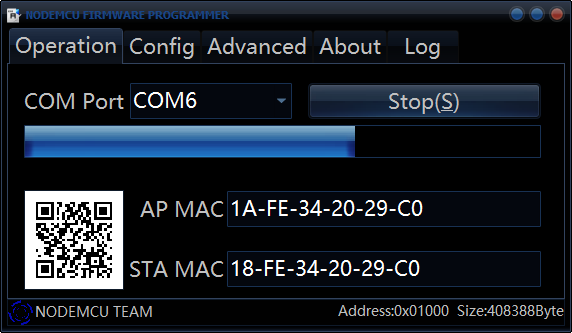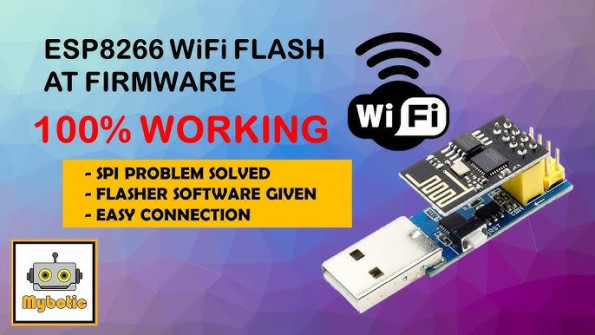
- ESP8266 FIRMWARE VERSIONS HOW TO
- ESP8266 FIRMWARE VERSIONS UPDATE
- ESP8266 FIRMWARE VERSIONS CODE
- ESP8266 FIRMWARE VERSIONS DOWNLOAD
ESP8266 FIRMWARE VERSIONS CODE
This project includes source code for a simple Flutter application which can target Android, iOS as well as other platforms which are supported by Flutter, and a robust C++ based firmware for Arduino/ESP8266/ESP32 devices. Run the flasher and open these files in the SDK…īoot_v1.2+.bin 0x00000 > Probably me just being a moron. Flutter ESP8266 IoT Starter Kit is a starter project for freelancers, indie developers, hobbyists and professionals. Get it here: .You can use the same flasher as before.Īgain, I prefer this Flash Programmer FLASH_DOWNLOAD_TOOLS_v2.3_150916 (available here: ). The highest AT firmware (as of 5th December 2017) you can put on the blue one is AT version 1.4.0. Do an AT+GMR command and you should give the correct response as listed above. Reset the module (make sure GPIO is NOT now connected to ground) and ensure you are using the correct Baud I think the flash program sets it to 115200. Copy and paste the memory addresses as given below. Anyway, run the flasher and open these files in the 1.4.0 SDK. The FOTA test has been demonstrated and run on the ESP-Launcher, an ESP8266 evaluation board designed by Espressif.
ESP8266 FIRMWARE VERSIONS UPDATE
This guide is intended to help you run a FOTA demonstration on the ESP8266 easily and quickly, with a PC acting as the local update server.
ESP8266 FIRMWARE VERSIONS DOWNLOAD
Hardware wise, ESP32’s are taking over from the older ESP8266 and are much more powerful and not much more expensive. ESP8266 device will download a new version of firmware from the update server over Wi-Fi and run it.

ESP8266 FIRMWARE VERSIONS HOW TO
Btw, you can put NodeMCU on an ESP-01 – YouTube around for instructions on how to do that. These ‘lower level’ SDK’s and the flasher programs are gettign harder and harder to find as the ESP01’s become more and more redundant, and “NodeMCU” firmware seems more popular compared to AT firmware. I much prefer to use this Flash Programmer (see bottom of page for an even better version) FLASH_DOWNLOAD_TOOLS_v2.3_150916 (available here: ). If you want a ‘boot’ version(?), Google for esp_iot_sdk_v1.3.0_15_08_08.zip and that’ll allow you to put version 0.40 Firmware on it. I’m not exactly sure what limitations (if any) result from this “no boot” thing but it works fine for me. This is apparently a “NO BOOT” firmware from a collection of files from the 1.4.0 SDK. The highest AT firmware you can put on the blue one is AT version 0.50. The classic ‘blue’ one has 512kBytes (4Mbits) for its flash memory, let me call it the ESP8266-01a or just ESP-01a,Īnd a black one that has 1MByte (8Mbits) memory let me call that the ESP8266-01b or ESP-01b module.

Updated SDK and Flasher Tools discussion at bottom of post.Īpparently, there are two version 1 modules. The flashing command of AT2 with esptool is esptool.py write_flash I recommend to change in nfig file flash_mode to qio if your ESP module supports it and flash frequency to 40MHz if your module doesn't support 80MHz.Edit: 1. AT 1.7 reference - it contains firmware flashing instructions tooĪT firmware 2.1.x is build on Espressif RTOS SDK for esp8266 and esp32.the Espressif binaries - versions 1.7.x.esptool.py write_flash -flash_size 1MB 0x0 boot_v1.7.bin 0x01000 at/512+512/.2.bin 0xfb000 blank.bin 0xfc000 esp_init_data_default_v08.bin 0xfe000 blank.bin 0x7e000 blank.binįor some esp8266 modules you will have to add -flash_mode dout before -flash_size. The AT 1.7.4 version has bin file for flashing to 1 MB flash. Flash Download Tool corrects it for 4 MB flash, but for esptool you should use the -flash_size 2MB-c1 option and the corresponding addresses. The Espressif AT binary is built for 2MB-c1 flash partitioning. AT firmware 1.7.x is build on Espressif NonOS SDK 3.


 0 kommentar(er)
0 kommentar(er)
